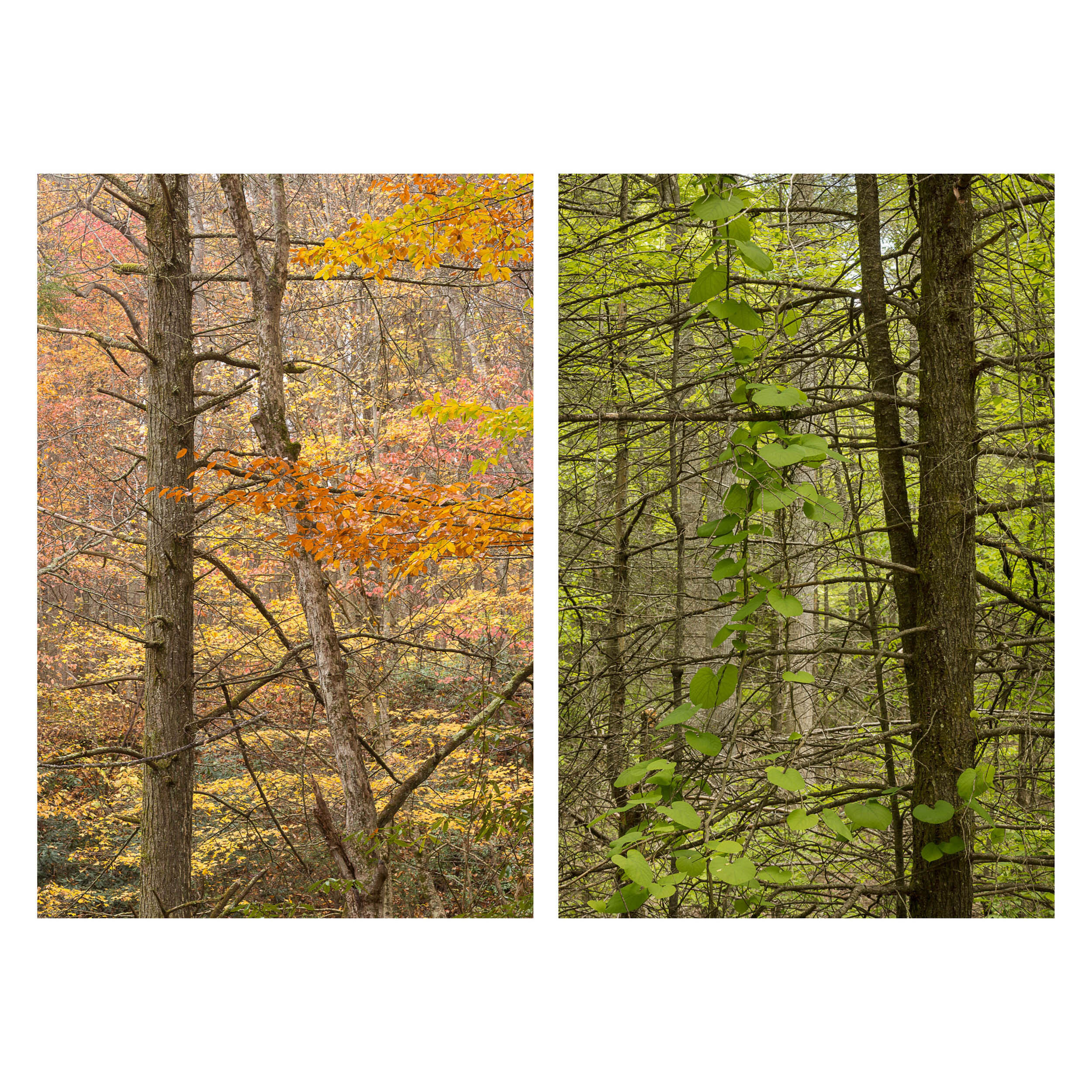Witness to Extinction: Elegy for the Eastern Hemlock
The great hemlock forests of the Appalachians are gone. Infestation by the woolly adelgid was gradual, beginning in 1952 from horticultural imports, and then spreading steadily reaching a tipping point in the early 2000’s, then rapidly consuming most of the forested areas tree by tree, grove by grove. Climate change, air borne pollution, and an unregulated horticulture industry all contributed to the demise of a defining ecosystem throughout the east.
The response to the threat was slow. Scientists and foresters identified and researched the problem but funding for the execution of any option was difficult. Too little, too late, although some pockets of trees in key areas remain protected.
What does this mean to our planet, to humankind, to you and I? Like most extinctions, our personal lives are largely unaffected. Therefore, we breathe a sigh of relief, with some remorse, but nevertheless a false sense of security from the seemingly detached situation. But if we believe that all of life is connected, and we understand the frailty of the balance that must be maintained, we can all raise our awareness to reach the threshold of taking action.
Yes, a forest grows back, nature replaces that which is lost. Light pours into the areas once shaded by these monumental trees, warming streams, fostering the growth of a new generation of flora, all competing for light. Those systems depending on the hemlocks will change or perish too. The machinery adjusts, the outcomes are largely unknown.
Disruption of a natural balance by human interaction almost universally results in an unwanted outcome. The functional extinction of an entire species of tree is significant. I am not here to pass judgement, or to render opinions of human behaviors. We have created the situations we must deal with.
I observed dying trees in the Great Smoky Mountains in various trips to photograph fall and spring foliage starting in 2009. I was attracted to the ghostly structures and graphic forms. The trees continued to catch my eye on subsequent trips but I didn’t pay attention to the issue causing the death, and dismissed it as part of the natural cycle of life and death in the forest.
My awareness of climate change consequences for our forests has deepened since I began focusing on forest ecosystems in my projects. Fire, wind, flood, pollution, disease, and insects, have devastated vast populations of trees, by species or by region. I remembered the great dying trees that I had encountered years ago. The first decade of 2000 happened to be the peak of HWA infestation, when the old growth hemlocks of the Great Smoky Mountains were lost. By 2007 most of the trees had died. As I began researching the issue I found that many people were sounding the alarm about the impending loss of the entire forest. All we could do was observe the inevitable reckoning of the insects. Trees hundreds of years old were taken down in a span of 2-3 years. Millions of trees, dying a slow death by infestation.
As I arrived at the Cataloochee campground, I could see dead hemlocks among a few living ones. But my heightened sensitivity to seeing hemlock carnage made me acutely aware of the amount of forest that had been affected. As I went about my hikes that’s all I could see, dead hemlocks. But the forest looked green and alive. It is mid-May and the forest is bursting with green everywhere. For the most part, the skeletons of hemlock remains were hidden among the living, part of the organic fabric of the landscape. But if you look closely, you can see and feel that something is not right.
Hiking on a trail forces your line of sight to be straight ahead or to the side. Rarely do you walk looking straight up. A dead tree trunk is well hidden among the full spring foliage of beech, maple, tulip, hickory, and oaks thriving in the forest. But looking up, one immediately sees the skeletonized branches and trunk in the space not yet filled in by the adjoining trees. The visual impact of this view is arresting.
There are many books and resources about the hemlock forests that inspire you to visit these places, and find what is left of these magnificent trees. I sought to document what exists now in this moment of 2019, about 20 years after the major onslaught of the killing. Evidence of the former grandeur of these trees still exist, but the forest is regenerating and that evidence is being returned to the earth. Eventually even the large dead trunks of the old growth trees will topple to the ground, the smaller dead trees will eventually be consumed by the natural recycling of the forest.
I am sad when I visit these areas. I mourn for the loss which took away from the splendor of a living landscape. Beings in existence hundreds of years, running at another pace of time, taken in an instant by the activity of man. Would it have eventually happened? Perhaps. Could it have been averted once identified? Perhaps not. The story of our discovery and reaction to the event continues. There are still great hemlock forests to the north and west. These are vulnerable and open to the same outcome. We can’t take action if we are unaware. We can’t address issues that aren’t even on our radars. With the competing deluge of news sensationalism we are desensitized to what is important. Trees eaten by bugs? What is that compared to the latest political shenanigans.
Rest assured that there are many concerned responsible citizens, scientists, foresters, and volunteers, all working on this issue. They have been for over 20 years. Their labors are hindered by funding and support from the public, and that’s why I’m hoping to contribute my small effort to raise awareness of these organizations so that you can help if this is important to you.
I reflect upon these woods and the changes in the forest. Year by year, changes occur. My uninformed visits in 2010 demonstrate clearly that I did not see enough to impact my thinking. Even though I photographed the carnage, I was not moved to take action. I am a different person now and hope to use my photography to elicit a response. At least it has for myself.
Doug Eng, 2019
A word on the photographs: When I reviewed images taken in 2009-2012, I was taken by the visible carnage and my attraction to the plight of these trees. I did not look at these images prior to my trip, nor did I remember the places these were taken. I never made prints. In 2019 I set out to confirm a vision of a “ghost” forest, something apocalyptic I thought I had seen. Instead I encountered a scattering of tree skeletons in different stages of decay. I never found my ghost forest, but plenty of expired hemlocks everywhere.
The images are paired – recent and past. These are not necessarily the same place, but I found it helpful to see the effect of time on the landscape. One was an informed view, the other uninformed. Some of the recent photographs include recent deaths. In the older photographs, I looked closely for hemlocks. I was surprised to see so many. I could be mistaken in identifying a dead tree as a hemlock, if I did it is because I am not qualified to make a true identification, my apologies. As an overall observation, I found the older images more interesting because I’m seeing things for the first time.
I plan to return to the Appalachians, to Shenandoah and to the great forests of the northeast to observe the progress of the HWA. I am scared of what I will find.



















